SAP vs ORACLE vs MICROSOFT DYNAMICS: A Comparative Study of Strengths, Weaknesses, and Tradeoffs
VerifiedAdded on 2024/05/16
|15
|2197
|399
AI Summary
This report provides a comprehensive analysis of three leading Enterprise Resource Planning (ERP) providers: SAP, Oracle, and Microsoft Dynamics. It delves into the strengths, weaknesses, and tradeoffs of each vendor, examining their market dominance, implementation duration, ownership cost, and realized business benefits. The report aims to provide a neutral perspective on the appeal of these ERP systems, helping organizations make informed decisions based on their specific needs and requirements. The analysis includes a detailed comparison of the vendors' features, functionalities, and market share, highlighting their strengths and weaknesses in various areas such as supply chain management, order processing, and inventory forecasting. The report also discusses the impact of cloud computing and SaaS models on the ERP landscape, exploring how these technologies are shaping the future of ERP solutions.
Contribute Materials
Your contribution can guide someone’s learning journey. Share your
documents today.
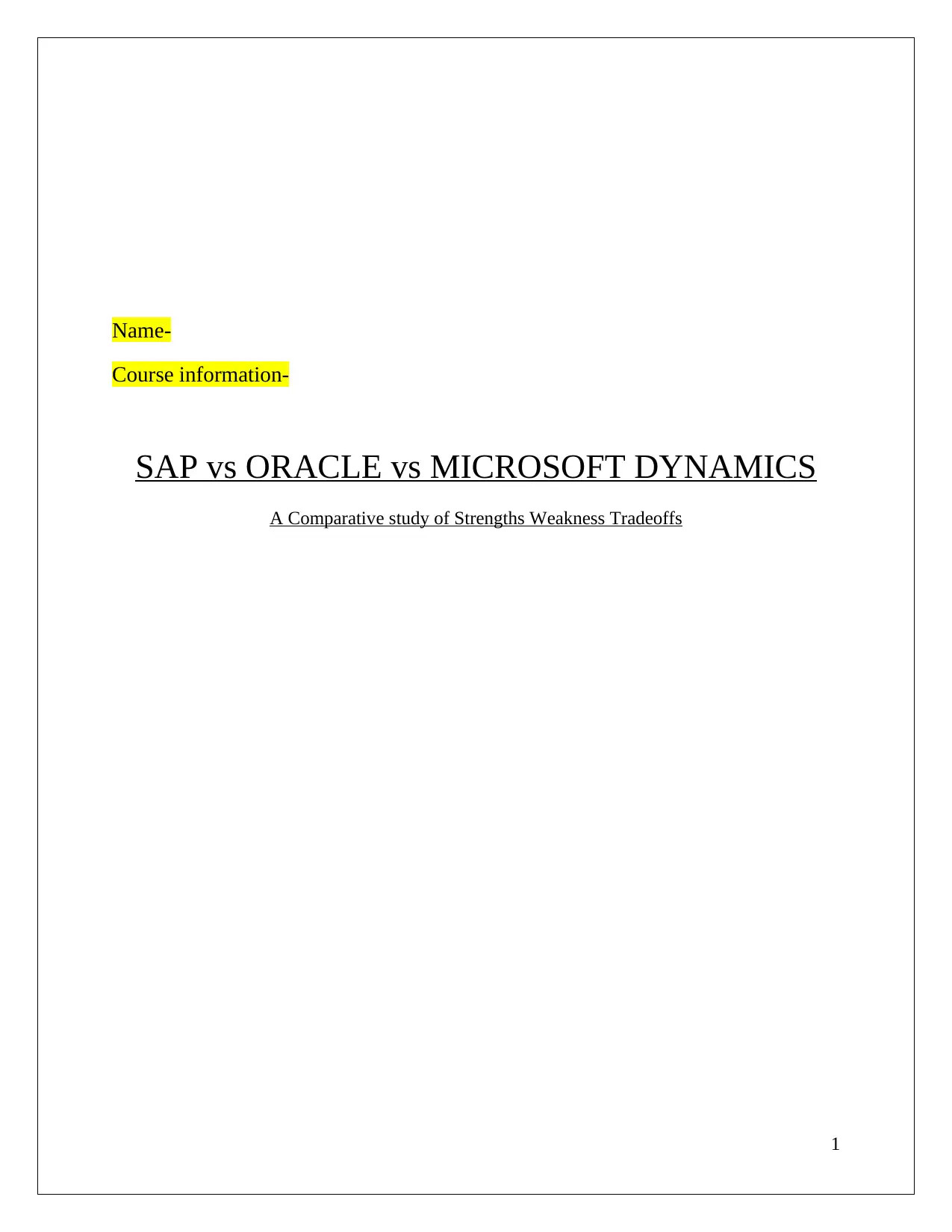
Name-
Course information-
SAP vs ORACLE vs MICROSOFT DYNAMICS
A Comparative study of Strengths Weakness Tradeoffs
1
Course information-
SAP vs ORACLE vs MICROSOFT DYNAMICS
A Comparative study of Strengths Weakness Tradeoffs
1
Secure Best Marks with AI Grader
Need help grading? Try our AI Grader for instant feedback on your assignments.
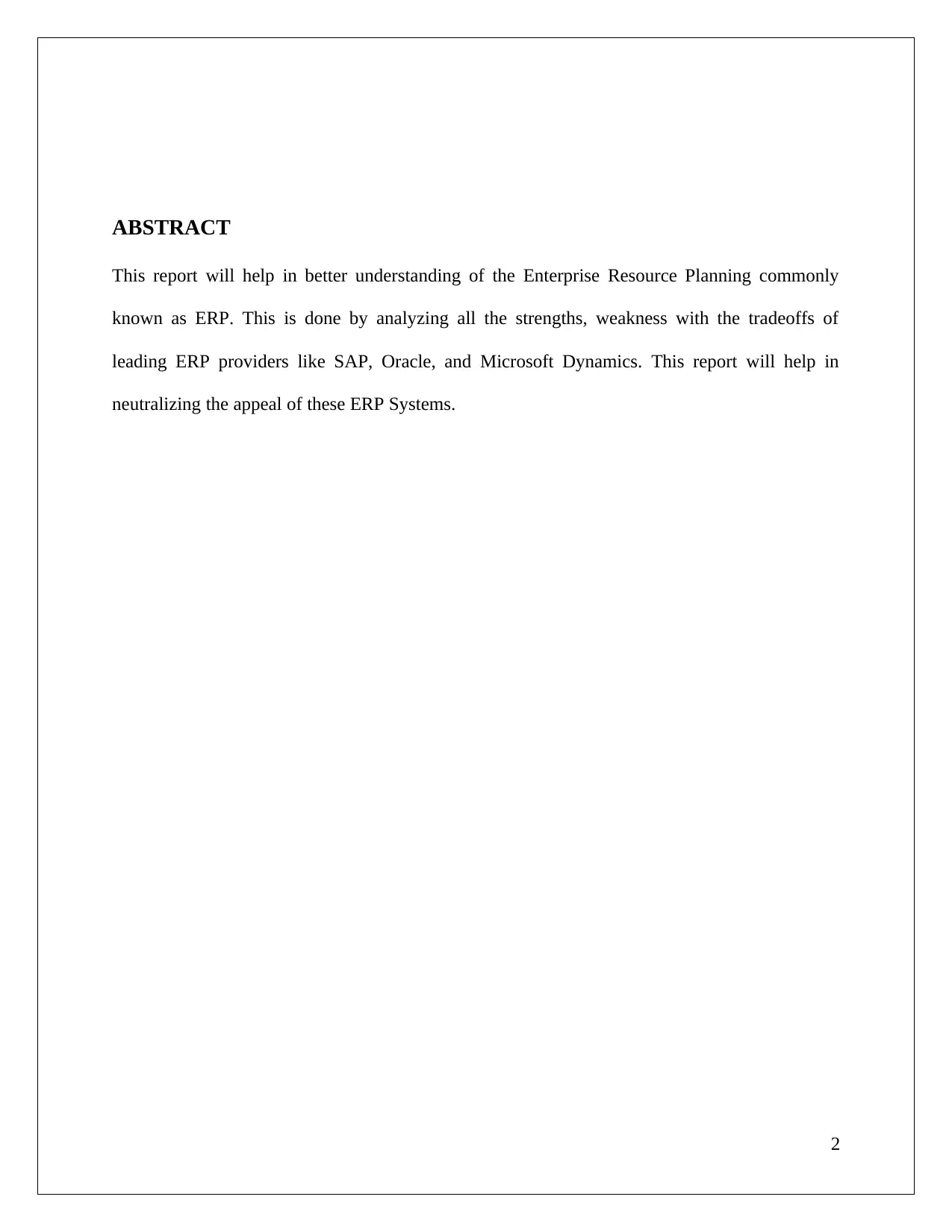
ABSTRACT
This report will help in better understanding of the Enterprise Resource Planning commonly
known as ERP. This is done by analyzing all the strengths, weakness with the tradeoffs of
leading ERP providers like SAP, Oracle, and Microsoft Dynamics. This report will help in
neutralizing the appeal of these ERP Systems.
2
This report will help in better understanding of the Enterprise Resource Planning commonly
known as ERP. This is done by analyzing all the strengths, weakness with the tradeoffs of
leading ERP providers like SAP, Oracle, and Microsoft Dynamics. This report will help in
neutralizing the appeal of these ERP Systems.
2
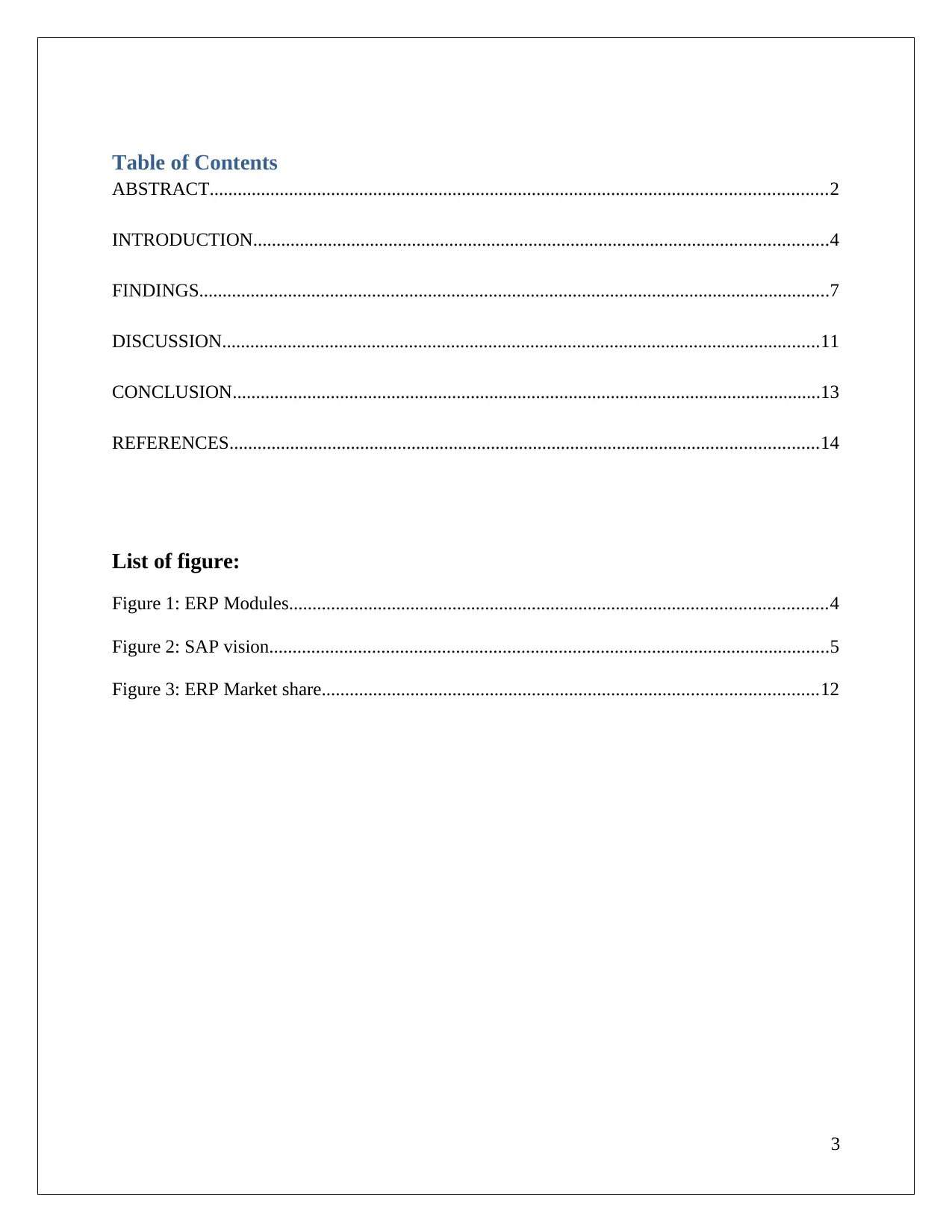
Table of Contents
ABSTRACT....................................................................................................................................2
INTRODUCTION...........................................................................................................................4
FINDINGS.......................................................................................................................................7
DISCUSSION................................................................................................................................11
CONCLUSION..............................................................................................................................13
REFERENCES..............................................................................................................................14
List of figure:
Figure 1: ERP Modules...................................................................................................................4
Figure 2: SAP vision........................................................................................................................5
Figure 3: ERP Market share..........................................................................................................12
3
ABSTRACT....................................................................................................................................2
INTRODUCTION...........................................................................................................................4
FINDINGS.......................................................................................................................................7
DISCUSSION................................................................................................................................11
CONCLUSION..............................................................................................................................13
REFERENCES..............................................................................................................................14
List of figure:
Figure 1: ERP Modules...................................................................................................................4
Figure 2: SAP vision........................................................................................................................5
Figure 3: ERP Market share..........................................................................................................12
3
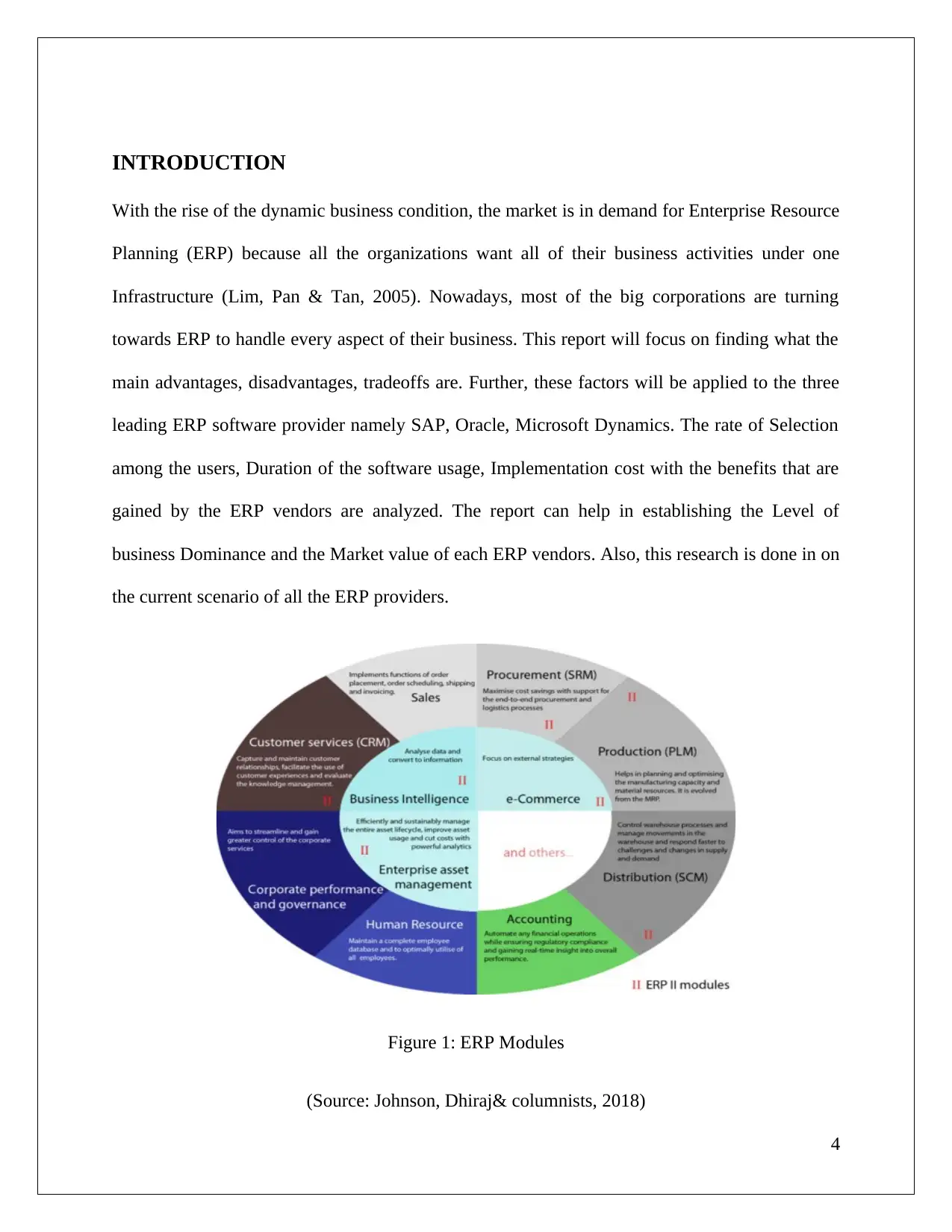
INTRODUCTION
With the rise of the dynamic business condition, the market is in demand for Enterprise Resource
Planning (ERP) because all the organizations want all of their business activities under one
Infrastructure (Lim, Pan & Tan, 2005). Nowadays, most of the big corporations are turning
towards ERP to handle every aspect of their business. This report will focus on finding what the
main advantages, disadvantages, tradeoffs are. Further, these factors will be applied to the three
leading ERP software provider namely SAP, Oracle, Microsoft Dynamics. The rate of Selection
among the users, Duration of the software usage, Implementation cost with the benefits that are
gained by the ERP vendors are analyzed. The report can help in establishing the Level of
business Dominance and the Market value of each ERP vendors. Also, this research is done in on
the current scenario of all the ERP providers.
Figure 1: ERP Modules
(Source: Johnson, Dhiraj& columnists, 2018)
4
With the rise of the dynamic business condition, the market is in demand for Enterprise Resource
Planning (ERP) because all the organizations want all of their business activities under one
Infrastructure (Lim, Pan & Tan, 2005). Nowadays, most of the big corporations are turning
towards ERP to handle every aspect of their business. This report will focus on finding what the
main advantages, disadvantages, tradeoffs are. Further, these factors will be applied to the three
leading ERP software provider namely SAP, Oracle, Microsoft Dynamics. The rate of Selection
among the users, Duration of the software usage, Implementation cost with the benefits that are
gained by the ERP vendors are analyzed. The report can help in establishing the Level of
business Dominance and the Market value of each ERP vendors. Also, this research is done in on
the current scenario of all the ERP providers.
Figure 1: ERP Modules
(Source: Johnson, Dhiraj& columnists, 2018)
4
Secure Best Marks with AI Grader
Need help grading? Try our AI Grader for instant feedback on your assignments.
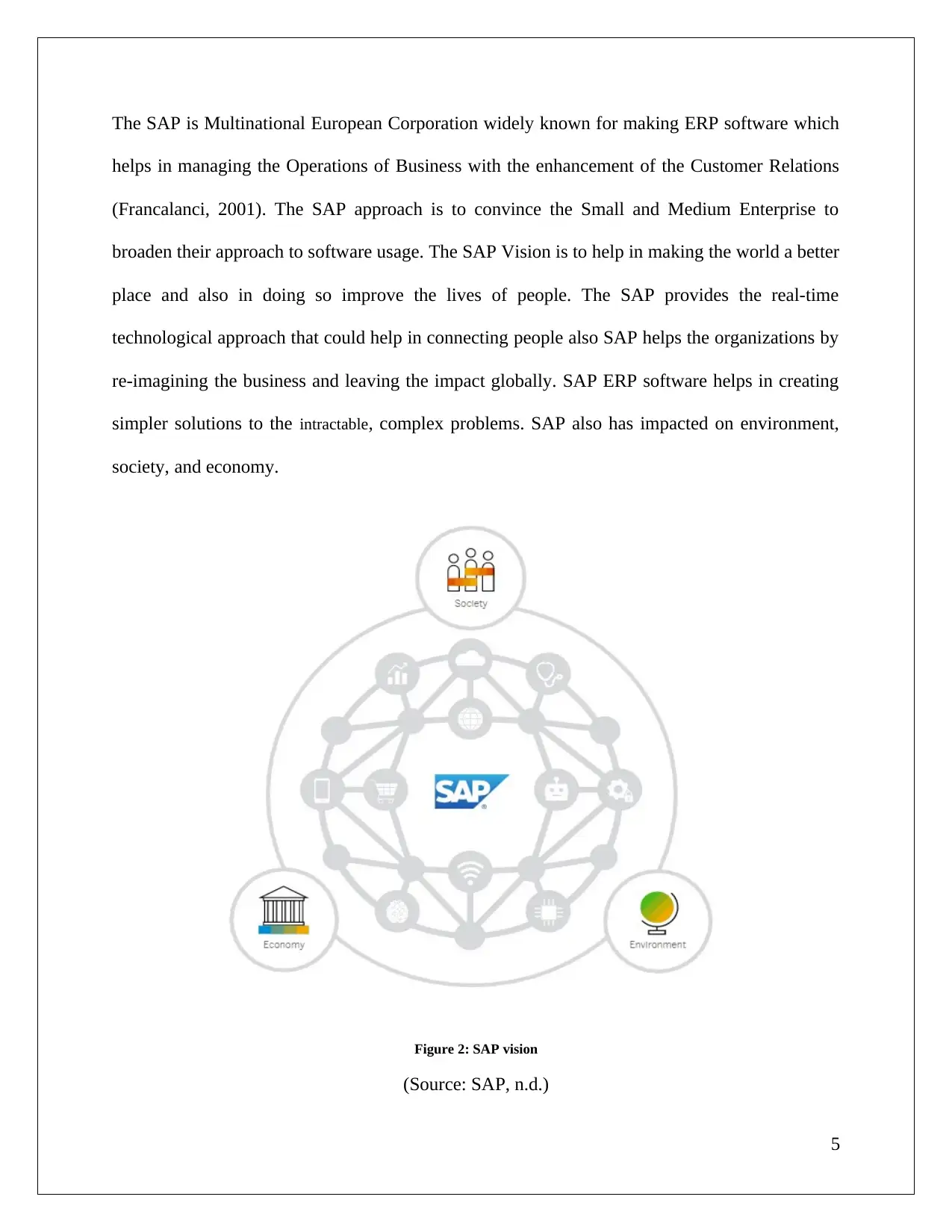
The SAP is Multinational European Corporation widely known for making ERP software which
helps in managing the Operations of Business with the enhancement of the Customer Relations
(Francalanci, 2001). The SAP approach is to convince the Small and Medium Enterprise to
broaden their approach to software usage. The SAP Vision is to help in making the world a better
place and also in doing so improve the lives of people. The SAP provides the real-time
technological approach that could help in connecting people also SAP helps the organizations by
re-imagining the business and leaving the impact globally. SAP ERP software helps in creating
simpler solutions to the intractable, complex problems. SAP also has impacted on environment,
society, and economy.
Figure 2: SAP vision
(Source: SAP, n.d.)
5
helps in managing the Operations of Business with the enhancement of the Customer Relations
(Francalanci, 2001). The SAP approach is to convince the Small and Medium Enterprise to
broaden their approach to software usage. The SAP Vision is to help in making the world a better
place and also in doing so improve the lives of people. The SAP provides the real-time
technological approach that could help in connecting people also SAP helps the organizations by
re-imagining the business and leaving the impact globally. SAP ERP software helps in creating
simpler solutions to the intractable, complex problems. SAP also has impacted on environment,
society, and economy.
Figure 2: SAP vision
(Source: SAP, n.d.)
5
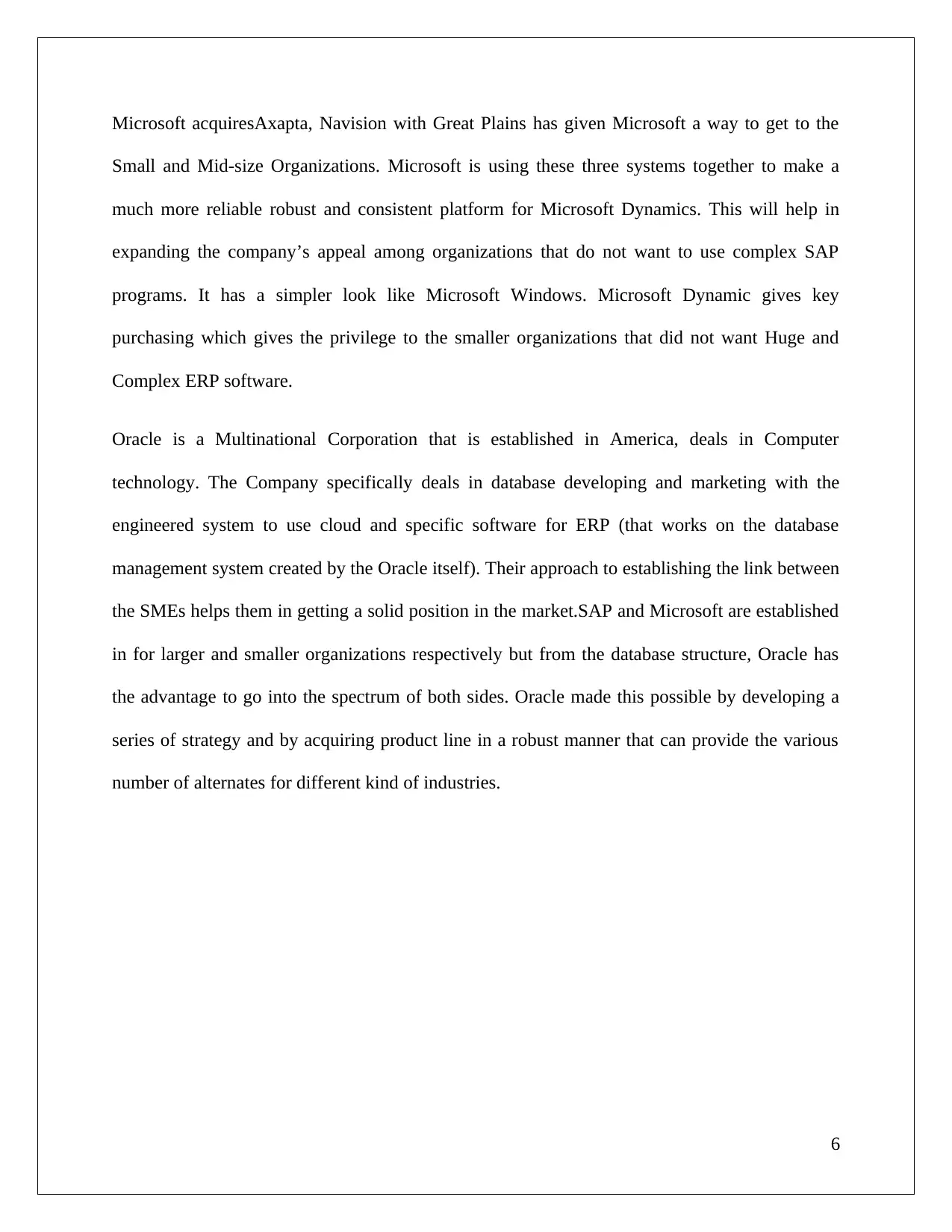
Microsoft acquiresAxapta, Navision with Great Plains has given Microsoft a way to get to the
Small and Mid-size Organizations. Microsoft is using these three systems together to make a
much more reliable robust and consistent platform for Microsoft Dynamics. This will help in
expanding the company’s appeal among organizations that do not want to use complex SAP
programs. It has a simpler look like Microsoft Windows. Microsoft Dynamic gives key
purchasing which gives the privilege to the smaller organizations that did not want Huge and
Complex ERP software.
Oracle is a Multinational Corporation that is established in America, deals in Computer
technology. The Company specifically deals in database developing and marketing with the
engineered system to use cloud and specific software for ERP (that works on the database
management system created by the Oracle itself). Their approach to establishing the link between
the SMEs helps them in getting a solid position in the market.SAP and Microsoft are established
in for larger and smaller organizations respectively but from the database structure, Oracle has
the advantage to go into the spectrum of both sides. Oracle made this possible by developing a
series of strategy and by acquiring product line in a robust manner that can provide the various
number of alternates for different kind of industries.
6
Small and Mid-size Organizations. Microsoft is using these three systems together to make a
much more reliable robust and consistent platform for Microsoft Dynamics. This will help in
expanding the company’s appeal among organizations that do not want to use complex SAP
programs. It has a simpler look like Microsoft Windows. Microsoft Dynamic gives key
purchasing which gives the privilege to the smaller organizations that did not want Huge and
Complex ERP software.
Oracle is a Multinational Corporation that is established in America, deals in Computer
technology. The Company specifically deals in database developing and marketing with the
engineered system to use cloud and specific software for ERP (that works on the database
management system created by the Oracle itself). Their approach to establishing the link between
the SMEs helps them in getting a solid position in the market.SAP and Microsoft are established
in for larger and smaller organizations respectively but from the database structure, Oracle has
the advantage to go into the spectrum of both sides. Oracle made this possible by developing a
series of strategy and by acquiring product line in a robust manner that can provide the various
number of alternates for different kind of industries.
6
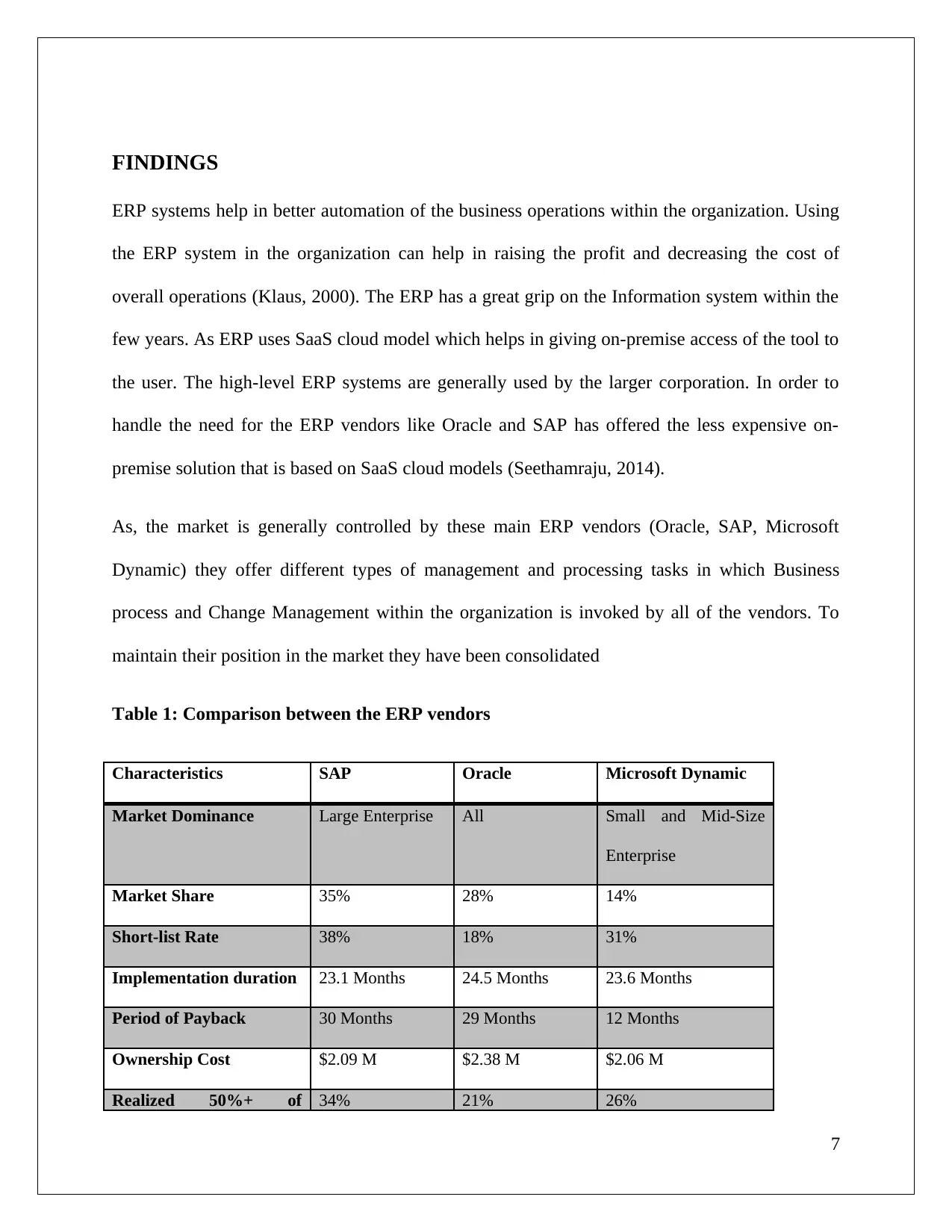
FINDINGS
ERP systems help in better automation of the business operations within the organization. Using
the ERP system in the organization can help in raising the profit and decreasing the cost of
overall operations (Klaus, 2000). The ERP has a great grip on the Information system within the
few years. As ERP uses SaaS cloud model which helps in giving on-premise access of the tool to
the user. The high-level ERP systems are generally used by the larger corporation. In order to
handle the need for the ERP vendors like Oracle and SAP has offered the less expensive on-
premise solution that is based on SaaS cloud models (Seethamraju, 2014).
As, the market is generally controlled by these main ERP vendors (Oracle, SAP, Microsoft
Dynamic) they offer different types of management and processing tasks in which Business
process and Change Management within the organization is invoked by all of the vendors. To
maintain their position in the market they have been consolidated
Table 1: Comparison between the ERP vendors
Characteristics SAP Oracle Microsoft Dynamic
Market Dominance Large Enterprise All Small and Mid-Size
Enterprise
Market Share 35% 28% 14%
Short-list Rate 38% 18% 31%
Implementation duration 23.1 Months 24.5 Months 23.6 Months
Period of Payback 30 Months 29 Months 12 Months
Ownership Cost $2.09 M $2.38 M $2.06 M
Realized 50%+ of 34% 21% 26%
7
ERP systems help in better automation of the business operations within the organization. Using
the ERP system in the organization can help in raising the profit and decreasing the cost of
overall operations (Klaus, 2000). The ERP has a great grip on the Information system within the
few years. As ERP uses SaaS cloud model which helps in giving on-premise access of the tool to
the user. The high-level ERP systems are generally used by the larger corporation. In order to
handle the need for the ERP vendors like Oracle and SAP has offered the less expensive on-
premise solution that is based on SaaS cloud models (Seethamraju, 2014).
As, the market is generally controlled by these main ERP vendors (Oracle, SAP, Microsoft
Dynamic) they offer different types of management and processing tasks in which Business
process and Change Management within the organization is invoked by all of the vendors. To
maintain their position in the market they have been consolidated
Table 1: Comparison between the ERP vendors
Characteristics SAP Oracle Microsoft Dynamic
Market Dominance Large Enterprise All Small and Mid-Size
Enterprise
Market Share 35% 28% 14%
Short-list Rate 38% 18% 31%
Implementation duration 23.1 Months 24.5 Months 23.6 Months
Period of Payback 30 Months 29 Months 12 Months
Ownership Cost $2.09 M $2.38 M $2.06 M
Realized 50%+ of 34% 21% 26%
7
Paraphrase This Document
Need a fresh take? Get an instant paraphrase of this document with our AI Paraphraser
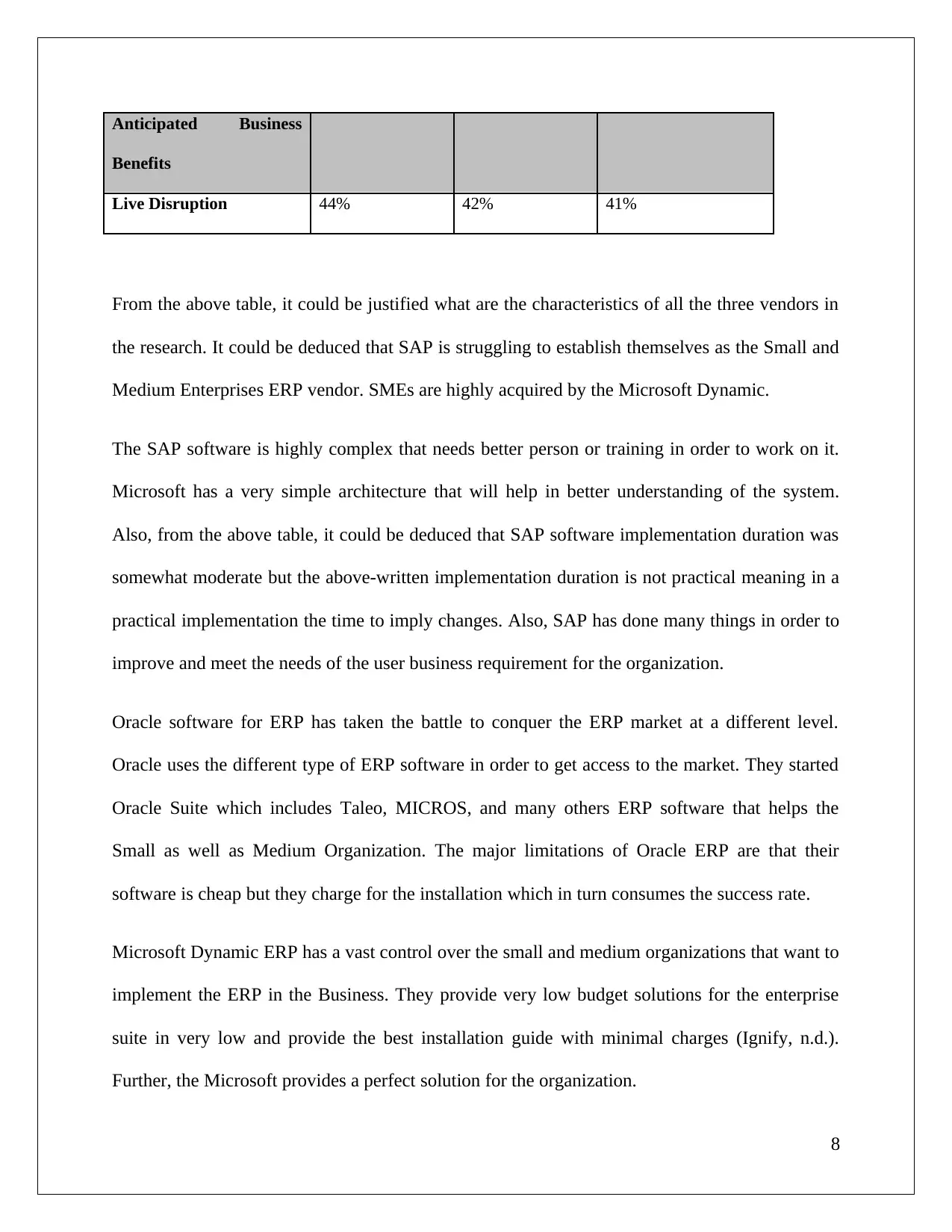
Anticipated Business
Benefits
Live Disruption 44% 42% 41%
From the above table, it could be justified what are the characteristics of all the three vendors in
the research. It could be deduced that SAP is struggling to establish themselves as the Small and
Medium Enterprises ERP vendor. SMEs are highly acquired by the Microsoft Dynamic.
The SAP software is highly complex that needs better person or training in order to work on it.
Microsoft has a very simple architecture that will help in better understanding of the system.
Also, from the above table, it could be deduced that SAP software implementation duration was
somewhat moderate but the above-written implementation duration is not practical meaning in a
practical implementation the time to imply changes. Also, SAP has done many things in order to
improve and meet the needs of the user business requirement for the organization.
Oracle software for ERP has taken the battle to conquer the ERP market at a different level.
Oracle uses the different type of ERP software in order to get access to the market. They started
Oracle Suite which includes Taleo, MICROS, and many others ERP software that helps the
Small as well as Medium Organization. The major limitations of Oracle ERP are that their
software is cheap but they charge for the installation which in turn consumes the success rate.
Microsoft Dynamic ERP has a vast control over the small and medium organizations that want to
implement the ERP in the Business. They provide very low budget solutions for the enterprise
suite in very low and provide the best installation guide with minimal charges (Ignify, n.d.).
Further, the Microsoft provides a perfect solution for the organization.
8
Benefits
Live Disruption 44% 42% 41%
From the above table, it could be justified what are the characteristics of all the three vendors in
the research. It could be deduced that SAP is struggling to establish themselves as the Small and
Medium Enterprises ERP vendor. SMEs are highly acquired by the Microsoft Dynamic.
The SAP software is highly complex that needs better person or training in order to work on it.
Microsoft has a very simple architecture that will help in better understanding of the system.
Also, from the above table, it could be deduced that SAP software implementation duration was
somewhat moderate but the above-written implementation duration is not practical meaning in a
practical implementation the time to imply changes. Also, SAP has done many things in order to
improve and meet the needs of the user business requirement for the organization.
Oracle software for ERP has taken the battle to conquer the ERP market at a different level.
Oracle uses the different type of ERP software in order to get access to the market. They started
Oracle Suite which includes Taleo, MICROS, and many others ERP software that helps the
Small as well as Medium Organization. The major limitations of Oracle ERP are that their
software is cheap but they charge for the installation which in turn consumes the success rate.
Microsoft Dynamic ERP has a vast control over the small and medium organizations that want to
implement the ERP in the Business. They provide very low budget solutions for the enterprise
suite in very low and provide the best installation guide with minimal charges (Ignify, n.d.).
Further, the Microsoft provides a perfect solution for the organization.
8
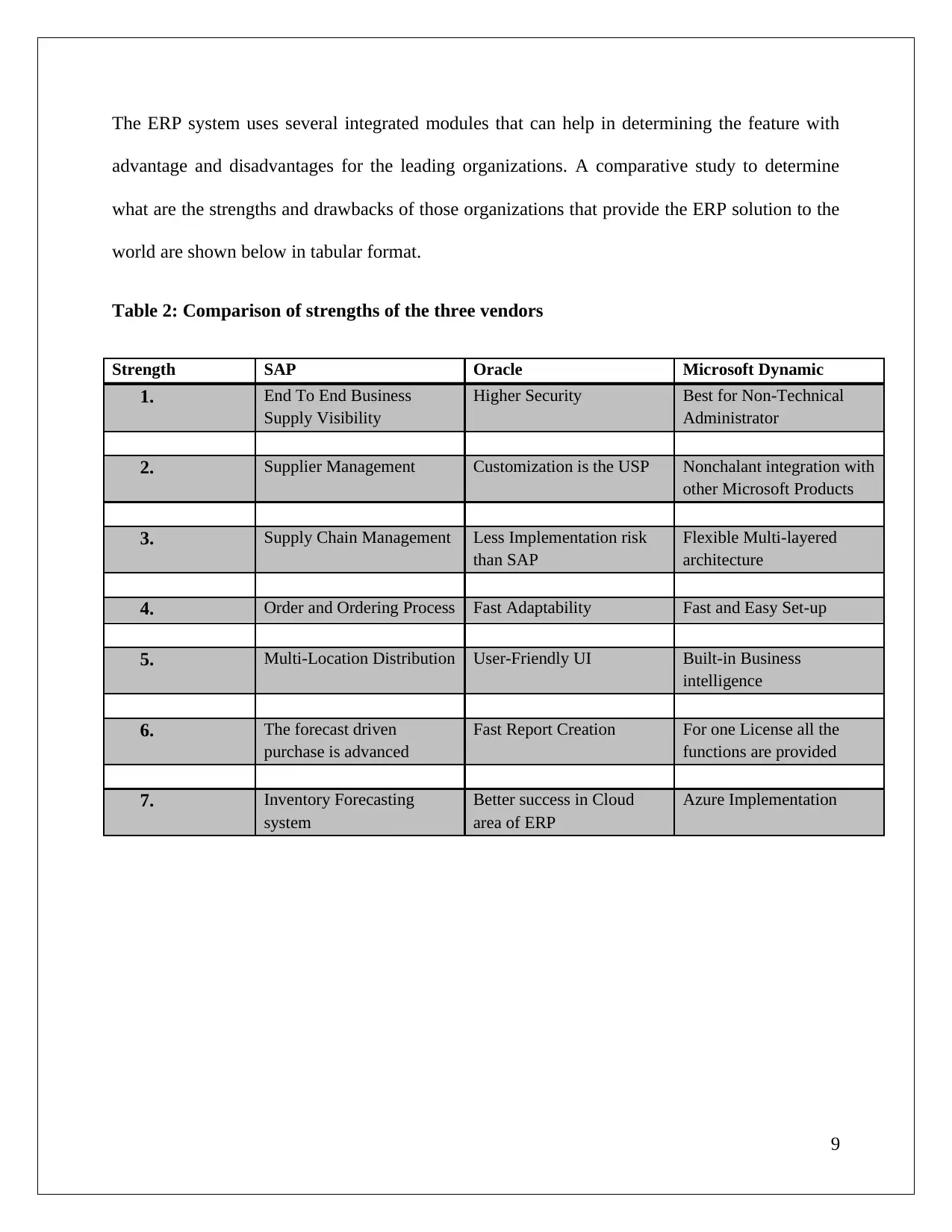
The ERP system uses several integrated modules that can help in determining the feature with
advantage and disadvantages for the leading organizations. A comparative study to determine
what are the strengths and drawbacks of those organizations that provide the ERP solution to the
world are shown below in tabular format.
Table 2: Comparison of strengths of the three vendors
Strength SAP Oracle Microsoft Dynamic
1. End To End Business
Supply Visibility
Higher Security Best for Non-Technical
Administrator
2. Supplier Management Customization is the USP Nonchalant integration with
other Microsoft Products
3. Supply Chain Management Less Implementation risk
than SAP
Flexible Multi-layered
architecture
4. Order and Ordering Process Fast Adaptability Fast and Easy Set-up
5. Multi-Location Distribution User-Friendly UI Built-in Business
intelligence
6. The forecast driven
purchase is advanced
Fast Report Creation For one License all the
functions are provided
7. Inventory Forecasting
system
Better success in Cloud
area of ERP
Azure Implementation
9
advantage and disadvantages for the leading organizations. A comparative study to determine
what are the strengths and drawbacks of those organizations that provide the ERP solution to the
world are shown below in tabular format.
Table 2: Comparison of strengths of the three vendors
Strength SAP Oracle Microsoft Dynamic
1. End To End Business
Supply Visibility
Higher Security Best for Non-Technical
Administrator
2. Supplier Management Customization is the USP Nonchalant integration with
other Microsoft Products
3. Supply Chain Management Less Implementation risk
than SAP
Flexible Multi-layered
architecture
4. Order and Ordering Process Fast Adaptability Fast and Easy Set-up
5. Multi-Location Distribution User-Friendly UI Built-in Business
intelligence
6. The forecast driven
purchase is advanced
Fast Report Creation For one License all the
functions are provided
7. Inventory Forecasting
system
Better success in Cloud
area of ERP
Azure Implementation
9
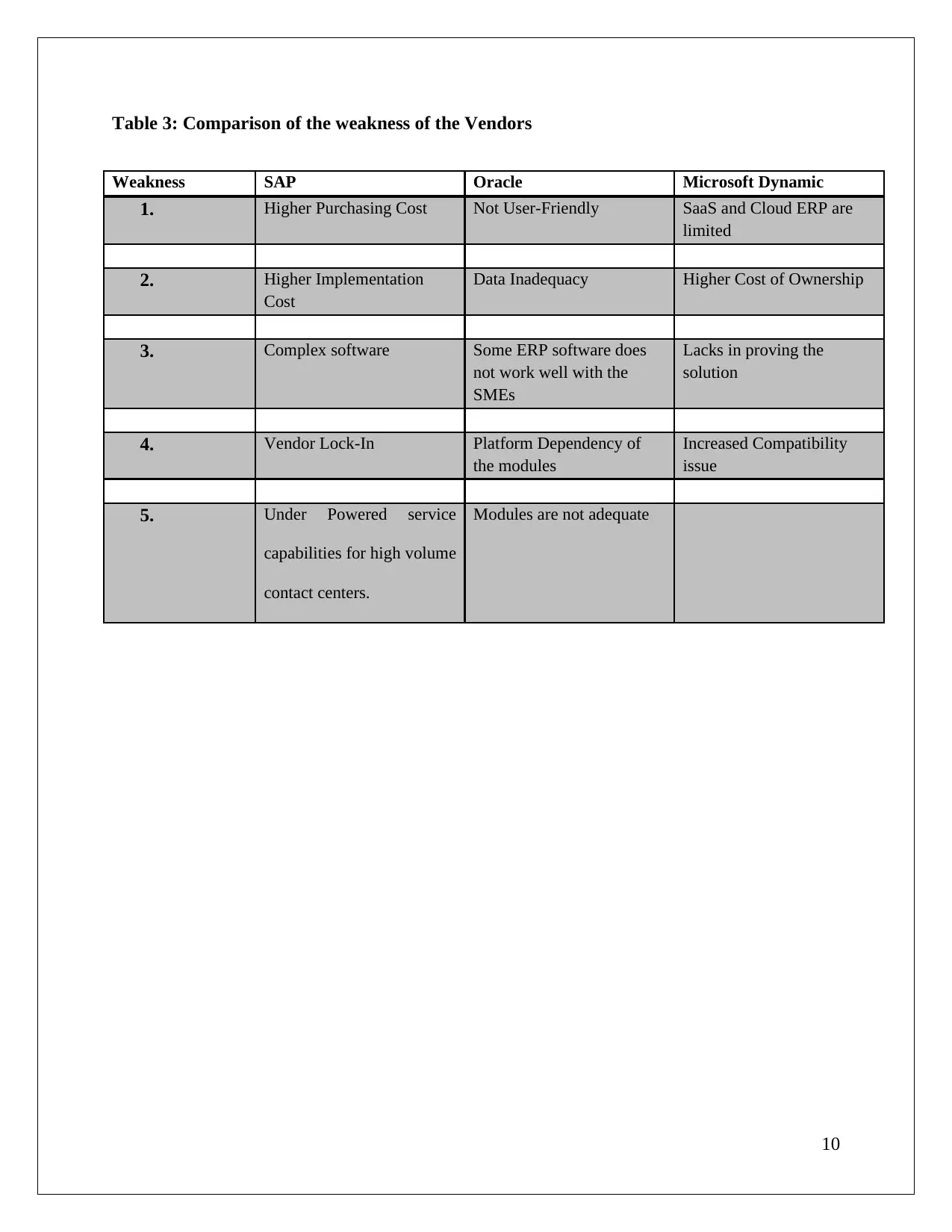
Table 3: Comparison of the weakness of the Vendors
Weakness SAP Oracle Microsoft Dynamic
1. Higher Purchasing Cost Not User-Friendly SaaS and Cloud ERP are
limited
2. Higher Implementation
Cost
Data Inadequacy Higher Cost of Ownership
3. Complex software Some ERP software does
not work well with the
SMEs
Lacks in proving the
solution
4. Vendor Lock-In Platform Dependency of
the modules
Increased Compatibility
issue
5. Under Powered service
capabilities for high volume
contact centers.
Modules are not adequate
10
Weakness SAP Oracle Microsoft Dynamic
1. Higher Purchasing Cost Not User-Friendly SaaS and Cloud ERP are
limited
2. Higher Implementation
Cost
Data Inadequacy Higher Cost of Ownership
3. Complex software Some ERP software does
not work well with the
SMEs
Lacks in proving the
solution
4. Vendor Lock-In Platform Dependency of
the modules
Increased Compatibility
issue
5. Under Powered service
capabilities for high volume
contact centers.
Modules are not adequate
10
Secure Best Marks with AI Grader
Need help grading? Try our AI Grader for instant feedback on your assignments.
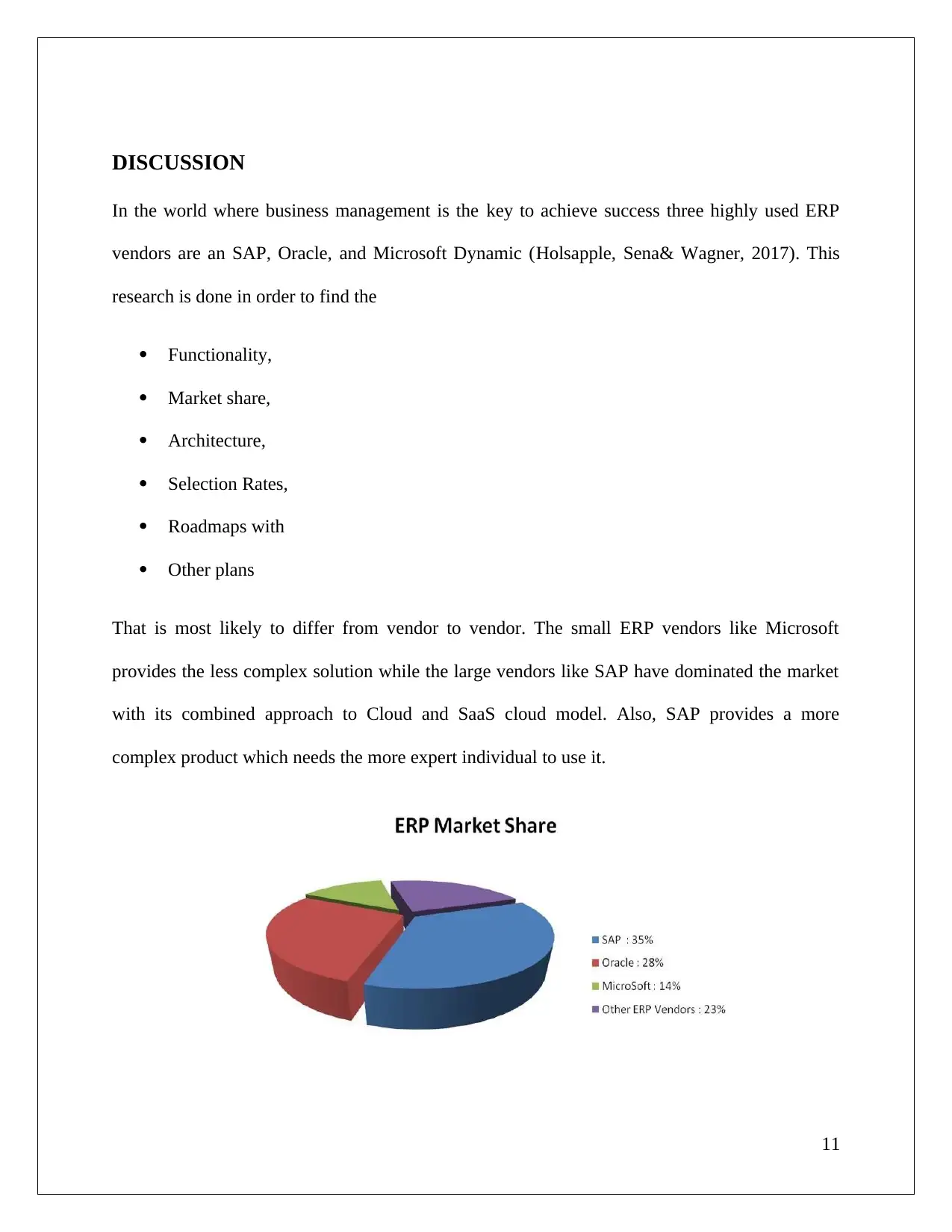
DISCUSSION
In the world where business management is the key to achieve success three highly used ERP
vendors are an SAP, Oracle, and Microsoft Dynamic (Holsapple, Sena& Wagner, 2017). This
research is done in order to find the
Functionality,
Market share,
Architecture,
Selection Rates,
Roadmaps with
Other plans
That is most likely to differ from vendor to vendor. The small ERP vendors like Microsoft
provides the less complex solution while the large vendors like SAP have dominated the market
with its combined approach to Cloud and SaaS cloud model. Also, SAP provides a more
complex product which needs the more expert individual to use it.
11
In the world where business management is the key to achieve success three highly used ERP
vendors are an SAP, Oracle, and Microsoft Dynamic (Holsapple, Sena& Wagner, 2017). This
research is done in order to find the
Functionality,
Market share,
Architecture,
Selection Rates,
Roadmaps with
Other plans
That is most likely to differ from vendor to vendor. The small ERP vendors like Microsoft
provides the less complex solution while the large vendors like SAP have dominated the market
with its combined approach to Cloud and SaaS cloud model. Also, SAP provides a more
complex product which needs the more expert individual to use it.
11
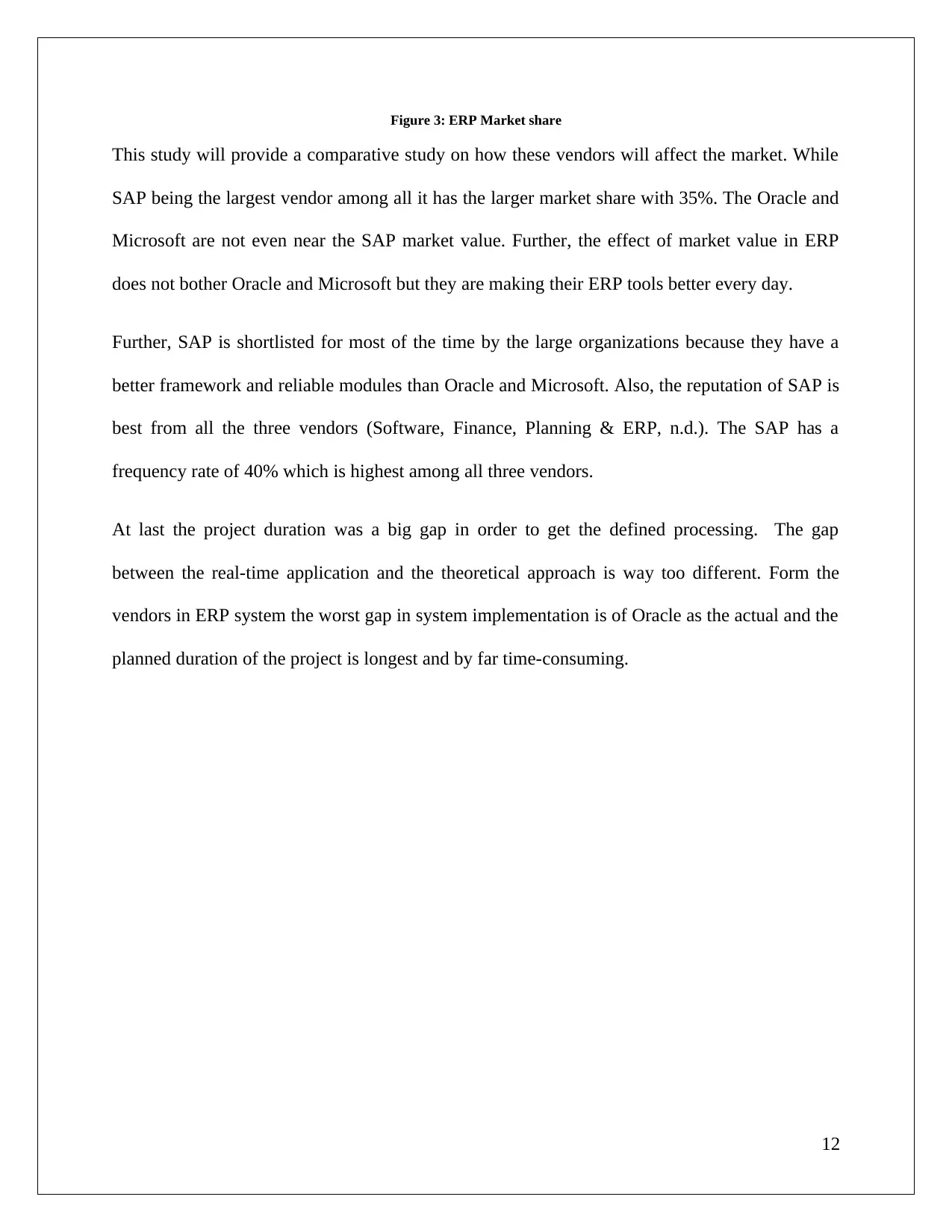
Figure 3: ERP Market share
This study will provide a comparative study on how these vendors will affect the market. While
SAP being the largest vendor among all it has the larger market share with 35%. The Oracle and
Microsoft are not even near the SAP market value. Further, the effect of market value in ERP
does not bother Oracle and Microsoft but they are making their ERP tools better every day.
Further, SAP is shortlisted for most of the time by the large organizations because they have a
better framework and reliable modules than Oracle and Microsoft. Also, the reputation of SAP is
best from all the three vendors (Software, Finance, Planning & ERP, n.d.). The SAP has a
frequency rate of 40% which is highest among all three vendors.
At last the project duration was a big gap in order to get the defined processing. The gap
between the real-time application and the theoretical approach is way too different. Form the
vendors in ERP system the worst gap in system implementation is of Oracle as the actual and the
planned duration of the project is longest and by far time-consuming.
12
This study will provide a comparative study on how these vendors will affect the market. While
SAP being the largest vendor among all it has the larger market share with 35%. The Oracle and
Microsoft are not even near the SAP market value. Further, the effect of market value in ERP
does not bother Oracle and Microsoft but they are making their ERP tools better every day.
Further, SAP is shortlisted for most of the time by the large organizations because they have a
better framework and reliable modules than Oracle and Microsoft. Also, the reputation of SAP is
best from all the three vendors (Software, Finance, Planning & ERP, n.d.). The SAP has a
frequency rate of 40% which is highest among all three vendors.
At last the project duration was a big gap in order to get the defined processing. The gap
between the real-time application and the theoretical approach is way too different. Form the
vendors in ERP system the worst gap in system implementation is of Oracle as the actual and the
planned duration of the project is longest and by far time-consuming.
12
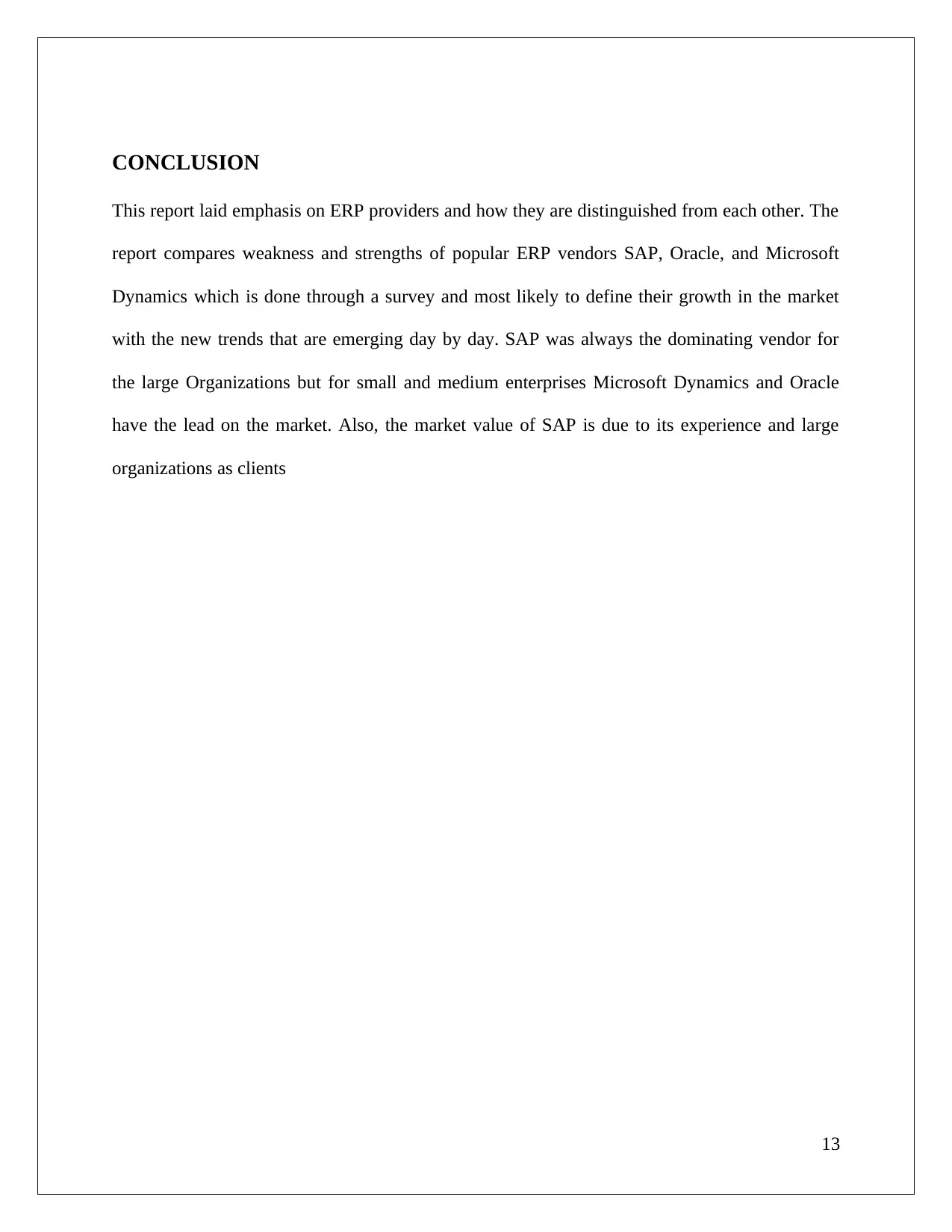
CONCLUSION
This report laid emphasis on ERP providers and how they are distinguished from each other. The
report compares weakness and strengths of popular ERP vendors SAP, Oracle, and Microsoft
Dynamics which is done through a survey and most likely to define their growth in the market
with the new trends that are emerging day by day. SAP was always the dominating vendor for
the large Organizations but for small and medium enterprises Microsoft Dynamics and Oracle
have the lead on the market. Also, the market value of SAP is due to its experience and large
organizations as clients
13
This report laid emphasis on ERP providers and how they are distinguished from each other. The
report compares weakness and strengths of popular ERP vendors SAP, Oracle, and Microsoft
Dynamics which is done through a survey and most likely to define their growth in the market
with the new trends that are emerging day by day. SAP was always the dominating vendor for
the large Organizations but for small and medium enterprises Microsoft Dynamics and Oracle
have the lead on the market. Also, the market value of SAP is due to its experience and large
organizations as clients
13
Paraphrase This Document
Need a fresh take? Get an instant paraphrase of this document with our AI Paraphraser
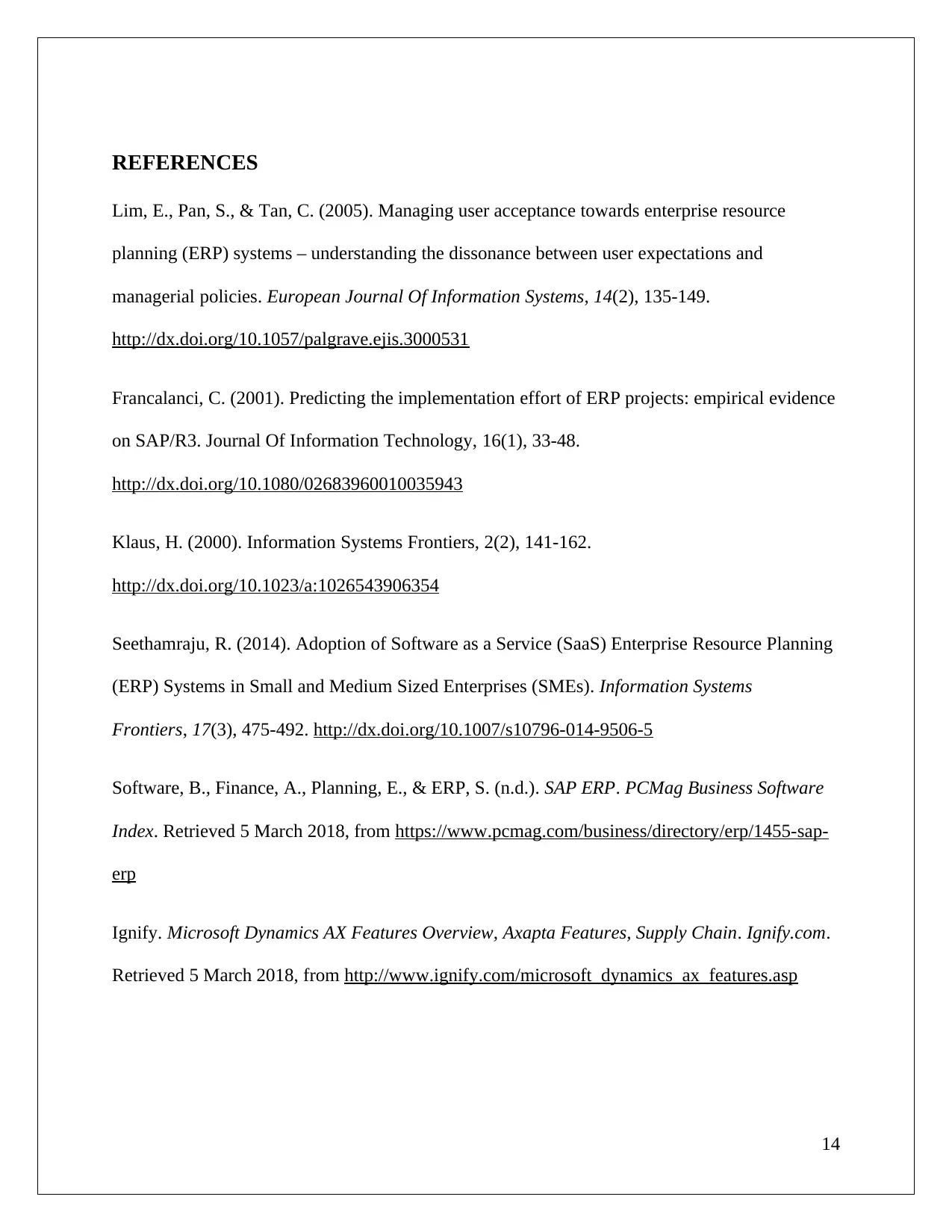
REFERENCES
Lim, E., Pan, S., & Tan, C. (2005). Managing user acceptance towards enterprise resource
planning (ERP) systems – understanding the dissonance between user expectations and
managerial policies. European Journal Of Information Systems, 14(2), 135-149.
http://dx.doi.org/10.1057/palgrave.ejis.3000531
Francalanci, C. (2001). Predicting the implementation effort of ERP projects: empirical evidence
on SAP/R3. Journal Of Information Technology, 16(1), 33-48.
http://dx.doi.org/10.1080/02683960010035943
Klaus, H. (2000). Information Systems Frontiers, 2(2), 141-162.
http://dx.doi.org/10.1023/a:1026543906354
Seethamraju, R. (2014). Adoption of Software as a Service (SaaS) Enterprise Resource Planning
(ERP) Systems in Small and Medium Sized Enterprises (SMEs). Information Systems
Frontiers, 17(3), 475-492. http://dx.doi.org/10.1007/s10796-014-9506-5
Software, B., Finance, A., Planning, E., & ERP, S. (n.d.). SAP ERP. PCMag Business Software
Index. Retrieved 5 March 2018, from https://www.pcmag.com/business/directory/erp/1455-sap-
erp
Ignify. Microsoft Dynamics AX Features Overview, Axapta Features, Supply Chain. Ignify.com.
Retrieved 5 March 2018, from http://www.ignify.com/microsoft_dynamics_ax_features.asp
14
Lim, E., Pan, S., & Tan, C. (2005). Managing user acceptance towards enterprise resource
planning (ERP) systems – understanding the dissonance between user expectations and
managerial policies. European Journal Of Information Systems, 14(2), 135-149.
http://dx.doi.org/10.1057/palgrave.ejis.3000531
Francalanci, C. (2001). Predicting the implementation effort of ERP projects: empirical evidence
on SAP/R3. Journal Of Information Technology, 16(1), 33-48.
http://dx.doi.org/10.1080/02683960010035943
Klaus, H. (2000). Information Systems Frontiers, 2(2), 141-162.
http://dx.doi.org/10.1023/a:1026543906354
Seethamraju, R. (2014). Adoption of Software as a Service (SaaS) Enterprise Resource Planning
(ERP) Systems in Small and Medium Sized Enterprises (SMEs). Information Systems
Frontiers, 17(3), 475-492. http://dx.doi.org/10.1007/s10796-014-9506-5
Software, B., Finance, A., Planning, E., & ERP, S. (n.d.). SAP ERP. PCMag Business Software
Index. Retrieved 5 March 2018, from https://www.pcmag.com/business/directory/erp/1455-sap-
erp
Ignify. Microsoft Dynamics AX Features Overview, Axapta Features, Supply Chain. Ignify.com.
Retrieved 5 March 2018, from http://www.ignify.com/microsoft_dynamics_ax_features.asp
14
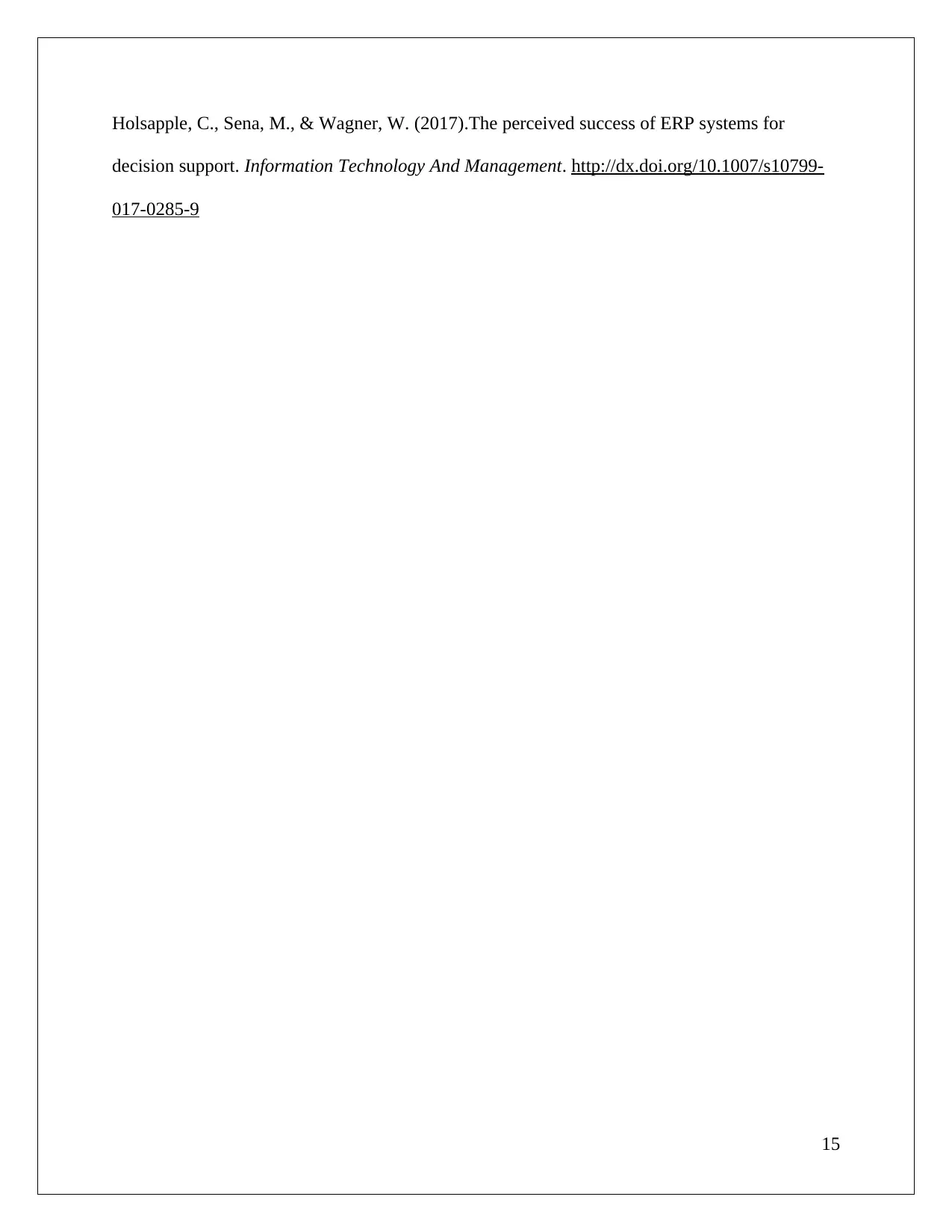
Holsapple, C., Sena, M., & Wagner, W. (2017).The perceived success of ERP systems for
decision support. Information Technology And Management. http://dx.doi.org/10.1007/s10799-
017-0285-9
15
decision support. Information Technology And Management. http://dx.doi.org/10.1007/s10799-
017-0285-9
15
1 out of 15
Your All-in-One AI-Powered Toolkit for Academic Success.
+13062052269
info@desklib.com
Available 24*7 on WhatsApp / Email
![[object Object]](/_next/static/media/star-bottom.7253800d.svg)
Unlock your academic potential
© 2024 | Zucol Services PVT LTD | All rights reserved.


